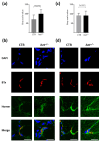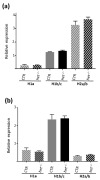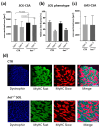Increased Homer Activity and NMJ Localization in the Vestibular Lesion het-/- Mouse soleus Muscle
- PMID: 39201265
- PMCID: PMC11354602
- DOI: 10.3390/ijms25168577
Increased Homer Activity and NMJ Localization in the Vestibular Lesion het-/- Mouse soleus Muscle
Abstract
We investigated the shuttling of Homer protein isoforms identified in soluble (cytosolic) vs. insoluble (membrane-cytoskeletal) fraction and Homer protein-protein interaction/activation in the deep postural calf soleus (SOL) and non-postural gastrocnemius (GAS) muscles of het-/- mice, i.e., mice with an autosomal recessive variant responsible for a vestibular disorder, in order to further elucidate a) the underlying mechanisms of disrupted vestibular system-derived modulation on skeletal muscle, and b) molecular signaling at respective neuromuscular synapses. Heterozygote mice muscles served as the control (CTR). An increase in Homer cross-linking capacity was present in the SOL muscle of het-/- mice as a compensatory mechanism for the altered vestibule system function. Indeed, in both fractions, different Homer immunoreactive bands were detectable, as were Homer monomers (~43-48 kDa), Homer dimers (~100 kDa), and several other Homer multimer bands (>150 kDA). The het-/- GAS particulate fraction showed no Homer dimers vs. SOL. The het-/- SOL soluble fraction showed a twofold increase (+117%, p ≤ 0.0004) in Homer dimers and multimers. Homer monomers were completely absent from the SOL independent of the animals studied, suggesting muscle-specific changes in Homer monomer vs. dimer expression in the postural SOL vs. the non-postural GAS muscles. A morphological assessment showed an increase (+14%, p ≤ 0.0001) in slow/type-I myofiber cross-sectional area in the SOL of het-/- vs. CTR mice. Homer subcellular immuno-localization at the neuromuscular junction (NMJ) showed an altered expression in the SOL of het-/-mice, whereas only not-significant changes were found for all Homer isoforms, as judged by RT-qPCR analysis. Thus, muscle-specific changes, myofiber properties, and neuromuscular signaling mechanisms share causal relationships, as highlighted by the variable subcellular Homer isoform expression at the instable NMJs of vestibular lesioned het-/- mice.
Keywords: Homer; NMJ; vestibular lesion.
Conflict of interest statement
The authors declare no conflicts of interest. The sponsors had no role in the design, execution, interpretation, or writing of the study.
Figures





Similar articles
-
Opposite Regulation of Homer Signal at the NMJ Postsynaptic Micro Domain between Slow- and Fast-Twitch Muscles in an Experimentally Induced Autoimmune Myasthenia Gravis (EAMG) Mouse Model.Int J Mol Sci. 2022 Nov 30;23(23):15052. doi: 10.3390/ijms232315052. Int J Mol Sci. 2022. PMID: 36499379 Free PMC article.
-
Reciprocal Homer1a and Homer2 Isoform Expression Is a Key Mechanism for Muscle Soleus Atrophy in Spaceflown Mice.Int J Mol Sci. 2021 Dec 22;23(1):75. doi: 10.3390/ijms23010075. Int J Mol Sci. 2021. PMID: 35008503 Free PMC article.
-
Expression and regulation of Homer in human skeletal muscle during neuromuscular junction adaptation to disuse and exercise.FASEB J. 2011 Dec;25(12):4312-25. doi: 10.1096/fj.11-186049. Epub 2011 Sep 1. FASEB J. 2011. PMID: 21885651
-
Preliminary Observations on Skeletal Muscle Adaptation and Plasticity in Homer 2-/- Mice.Metabolites. 2021 Sep 19;11(9):642. doi: 10.3390/metabo11090642. Metabolites. 2021. PMID: 34564458 Free PMC article.
-
Homer protein family regulation in skeletal muscle and neuromuscular adaptation.IUBMB Life. 2013 Sep;65(9):769-76. doi: 10.1002/iub.1198. Epub 2013 Aug 5. IUBMB Life. 2013. PMID: 23913637 Review.
References
-
- Brosel S., Strupp M. The Vestibular System and Ageing. Subcell. Biochem. 2019;91:195–225. - PubMed
MeSH terms
Substances
LinkOut - more resources
Full Text Sources
Research Materials

